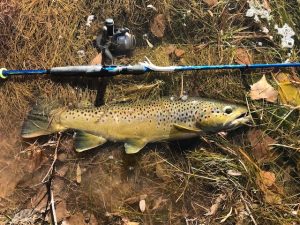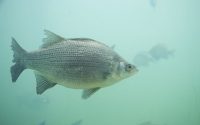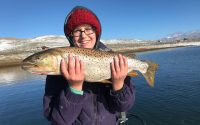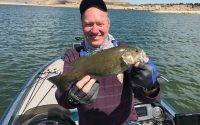Brown Trout Spawn – “Be Careful Out There”

Without a doubt, (in rivers, streams and even reservoirs in Utah) fall brings the brown trout spawn with some incredible fishing (catching) opportunities. Let’s discuss this important time of year and highlight some of the ways to enjoy catching quality fish while protecting the areas in which they spawn.
Brown trout or commonly known as “German browns” are hearty fish that adapt well to all types of Utah trout waters. They can thrive in poorer water quality than other species, and are less susceptible to parasites like those that bring on whirling disease, and thus, browns have replaced rainbows in waters such as the Provo River, and other such streams throughout Utah.
They are beautiful fish and are easily identifiable with a golden brownish main body and a yellow underbelly. Black and red spots highlight the sides of the fish and they do not have a distinct white line on the bottom or lower edge of the pectoral fins, one of the distinguishing characteristics of brook trout, another popular stream-dwelling trout species.
Between now and the start of winter, female browns will clear off shallow areas (on gravel bars) of algae and other bottom vegetation and dig their nests (known as “redds”) in the gravely current. In preparation for the spawn, both males and females bunch up and become aggressive, striking at almost any lure or fly presented near their “redds.”
“Redds” can be as small as a volleyball or can cover an area the size of the automobile. The key feature is a totally clean section of gravel, always in an area with at least a moderate flow of current over the top.
Personally, I have enjoyed fishing for pre-spawn brown trout using lures such as tiny, floating Rapalas in rainbow or brown trout colors and, believe it or not, finesse tube jigs (two to three inches long) with 1/16 to 1/4-ounce weights (depending on the amount of current) in black, white, or green colors on a spinning rod; and streamers (in similar colors) and even typical nymph patterns on a fly rod.
However, every angler wanting to catch aggressive, healthy brown trout before, during and after the spawn must be careful not to destroy a fishery while just wanting to catch some quality fish. Yes, I recommend catch and release this time of year, but that is not nearly as important as being careful not to destroy the “redds” in the process.
Understanding “Redds”
Allow me to explain.
Female brown trout lay their eggs as the males pass over the “redds” and fertilize the eggs which settle into the cleaned gravel nests. Unlike other species (eggs hatch within a few days), brown trout eggs don’t hatch until one to two months after they are fertilized. This process leaves the “incubator” (the entirety of the cleaned “redds”) vulnerable to intrusions by unknowing or careless anglers.
Since water levels in most brown trout waters are lower in the fall and winter, many anglers choose to wade as they fish. “Redds” are easy to see in the shallow water but if anglers stand on or “shuffle” through an active nest, the eggs could become dislodged, roll away and become food for other fish rather than becoming the next generation of brown trout.
Remember, that if brown trout were to spawn in the first part of November, their eggs may not hatch until sometime in early January. So, any disturbance of their nests could completely destroy the spawn for that year.
How to Safely Fish for Browns
If you want to fish for browns in the next three months, try to follow these simple but very important rules.
- Try to fish as much as possible from the bank.
- When wading, be aware of the environment and don’t wade immediately above an active “redd.”
- Use barbless hooks when possible and immediately release the fish you catch.
By following these simple rules, the next few months can be a great time to catch some quality brown trout all over the state. Remember, “Be Careful Out There.”










